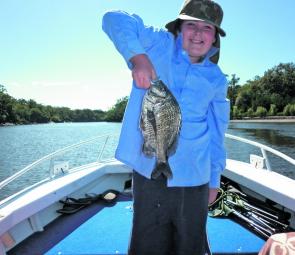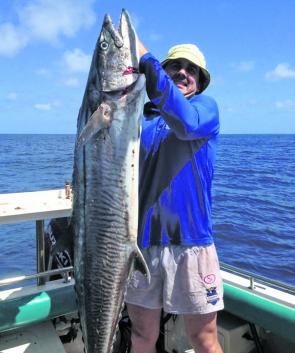September couldn’t come on quick enough and I say bring on the change in seasons, Those rotten August westerlies have given us a bit of curry lately by shutting down the bite just when we thought there would be a great session.
The theories vary a little but it has something to do with the barometric pressure associated with the westerly wind. It is thought that a small change in pressure up or down can trigger a bite but a little more either way can close it down. Long periods of high or low will also shutdown the fishes urge to feed and as soon as the pressure changes again it can make the whole system become active again. I try to plan my trips around these small changes or following inactive periods. When the timing is right the results follow.
Like previous wet starts to the year a milder winter followed and many of the summer fish never really left they just slowed a bit when the temperatures dropped. Now that the gauge is rising they have picked up once more and the lead into summer is shaping up to be another good one.
The estuary outlook is barramundi, fingermark, mangrove jack, flathead, bream, king salmon and blue salmon. Flathead season is really on as they congregate in the estuary mouths to spawn. They line the channel edges where they can sneak up over the banks with the rising tides. It is not uncommon to see small groups sitting just out of the main current in eddies or pressure waves at the ends of islands and sand banks.
Lures or bait both work and it doesn’t seem to make any difference because flatties will nail anything that looks like a feed if it passes close enough to them.
Fingermark have been quiet the past year or so for some reason but the numbers turning up in the last week or so are well above the norm. All the old spots have started to fire especially the areas down through The Fitzroy River delta and down into The Narrows.
The Ramsay Crossing boat ramp is a great starting spot with lots of rocks and structure to hold fingermark. Many of the regulars troll along the banks and around the bars leading up to and over the high tide. Coorooman Creek and Corio Bay both have plenty of fingeries and the blokes who chase them here use lives baits instead of lures as a rule.
Rosslyn Bay Harbour is another location where it is possible to score quality fingermark around the walls and through the marina under the walkways. The outside walls down to The Blowhole is very good for fingermark, but like the inside the best times are when the boat traffic is slow or at night.
The next hotspot is up into Army Country where the close in islands and the rocky areas of Port Clinton are prime territory. In central Queensland they prefer rocky locations like rock walls and rugged rock bars with a bit of depth around them.
The method used is up to the individual although you can cover a lot more country with lures than baits. It pays to have a range of lures so that they suit the depth you are working as the best lure is the one that touches bottom occasionally kicking up a puff of mud or sand and making a bit of noise.
Anglers use many different makes of lures and most of them work. I have a stack of different Richoes used mainly for barramundi that cover every depth and situation so I don’t need to buy anything else. Over the years the bigger lures did the trick until a recent trip away where 75mm deep diving Tiny Terrors outshone every other type.
Poddy mullet, whiting, greenback herring, yorkies and big prawns are all great live baits although fingermark will take all these as dead baits if they are fresh. Fingermark fight strong and dirty particularly close to the structures where they can bust you up very quickly. 30lb braid with 50lb leader is pretty much where you start; anything much lighter can give an aggressive fingermark too much advantage.
Blue salmon have been turning up in numbers along the coast, into the estuary mouths and inside Rosslyn Bay Harbour. The schools of blue salmon have come into the harbour with the schools of herrings and white bait. They will come again with the run of northern pilchards, which occurs anywhere in the next month or so.
When the salmon are firing you can see them smashing the bait schools; almost like tuna at times. Live yabbies, greenback herring or prawns are best and whiting fillets or pillies are a good backup.
One trick with live yabbies is to hook three or four of them on at a time through the tail, keeping them alive and active trying to get away from the hook. The best lures are Flashas and Pegrons worked through the school erratically with pauses and jigs in the retrieve.
Spotted mackerel will begin to turn up along the Capricorn Coast in September. These guys are fine table fish and usually travel in close to shore giving the locals a shot at them. Spotties don’t mind the murkier waters of Keppel Bay and can often stay when other mackerels have headed on to cleaner spots.
Quartz Rock and Little Quartz out from Keppel Sands, and Cave and Wedge isles just off Emu Park are the pick spotted mackerel spots. The common feature of these areas is a fair current run eddying and creating a current line. We try to anchor on the line and pull our lures across the movement from the still water.
Chromies and slugs work very well with a reasonably quick retrieve. Add a couple of jigging motions and spotties will jump on if they are around. The regular rig consists of a 6kg main line tied to a 20kg leader approximately 1.5m long. This runs to a swivel attached to the lure by a split ring, which allows the lure a bit more action without twisting your line.
Flashas, Pegrons and Bumper Bars work very well and at a couple of bucks each it doesn’t take many macks to cover the cost. A floating pilchard is another way to grab a few spotties and you can add or remove lead to sink or float the pilly to the depth the fish are feeding.
Spanish mackerel have had another spurt as reports come in from just about all the mackerel ground from the islands to the northern and wide grounds. The average sized fish has risen slightly from 6kg in the last couple of months to around 10kg at the moment.
The early morning bigger tides are best and the choice bait will be the size of the fish in the passing bait schools. As usual floating pillies to trolled bonito or ribbonfish will do the job. A live iodine bream hanging under a float is probably the easiest way to catch Spaniards and it keeps the mackerel lines wide of the bottom fishing rigs.
Reefies are in good supply from trout, nannygai, reds and sweetlip all in form. In the cooler months we seem to get the best catches in the afternoon while the warmer months produce better at night or early morning.
Reads: 3264
Adrian Winchester with a very fine red emperor.

Ben Robertson with a 32cm bream caught at Waterpark Creek.

Clinton Geddes landed this massive 26kg Spaniard at Liza Jane on live bait.

Nathan with a horse of a coral trout caught while tagging in the green zones.




